All products featured are independently chosen by us. However, SoundGuys may receive a commission on orders placed through its retail links. See our ethics statement.
The best headphones for electronic drums
August 1, 2024





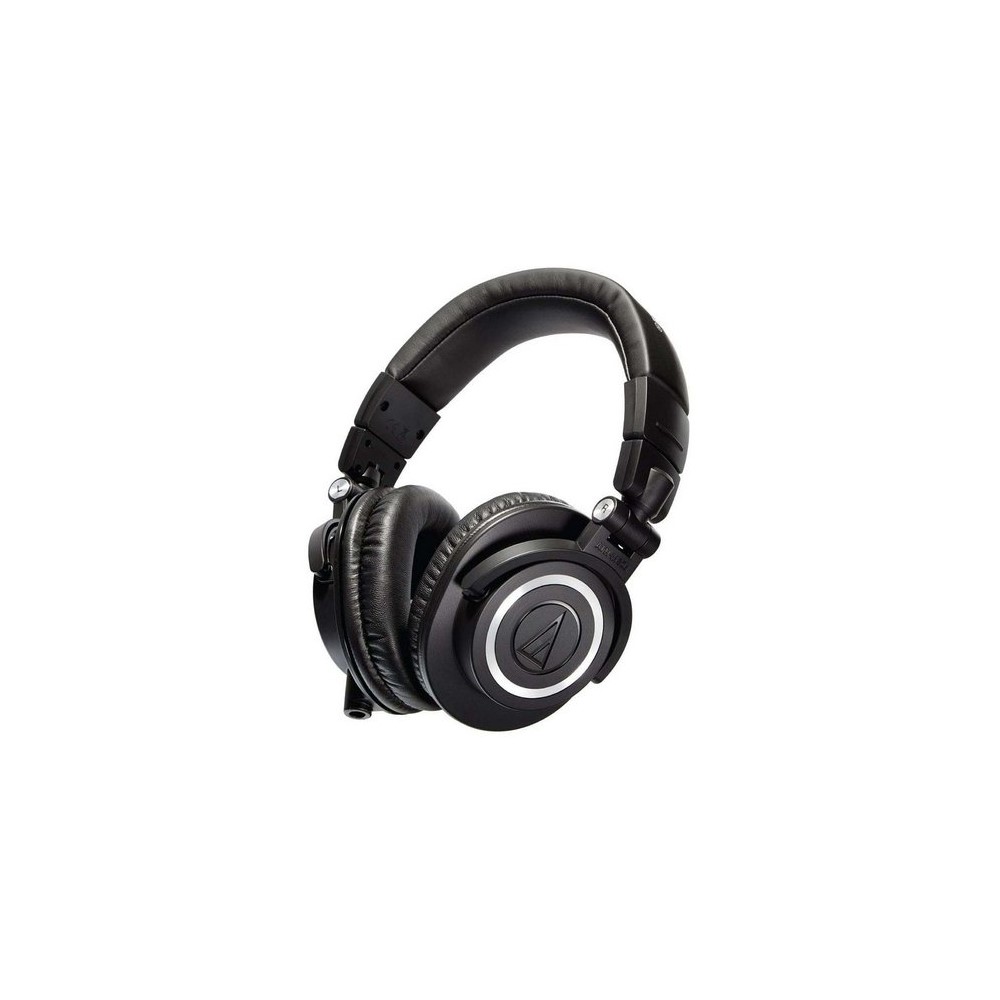
Take SoundGuys’ quiz to find your best fit
Choosing the best headphones for electronic drums is a tricky business. What constitutes the most pleasing sound quality is as subjective and divisive as music taste itself. So it is that what works for you may not work for others. Subsequently, it can be hard to know which cans are right for you. From open-back headphones to in-ear monitors and everything in between, drummers have a dizzying number of headphones to pick. Given that everybody has different needs, we have compiled a list of the best options for most people based on objective performance and specific feature sets.
Editor’s note: this list was published on August 01, 2024, and is the first version of the article. Updates will follow as the market changes.
Looking for something else?
- This list mostly comprises closed- and open-back over-ear headphones. If you play an acoustic drum kit or want something with excellent noise isolation, see our list of the best in-ear monitors.
- If you are shopping with a small budget, check our list of the best wired headphones under $50.
The Beyerdynamic DT 770 Pro (80Ω) are the best headphones for electronic drums for most people
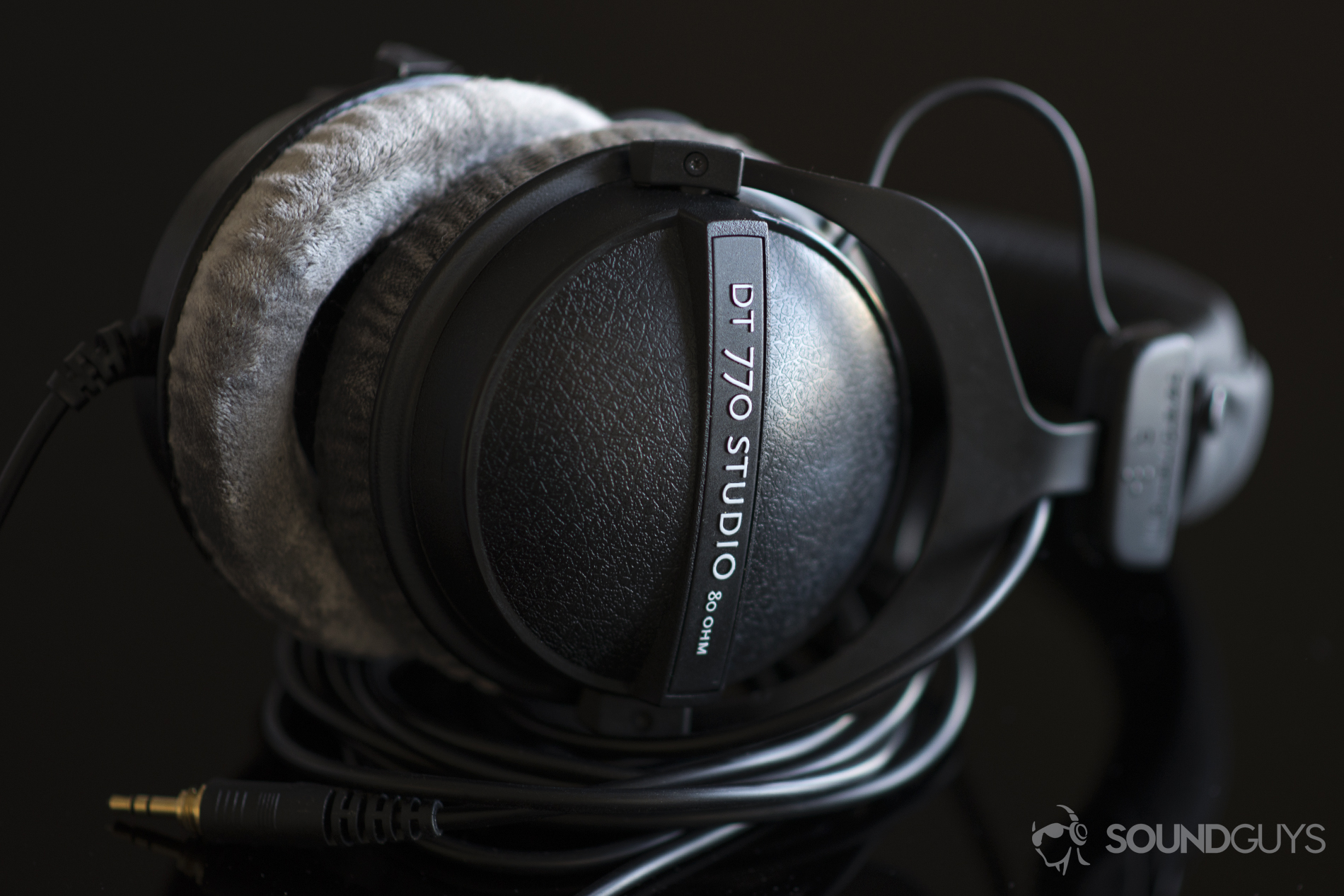
The Beyerdynamic DT 770 PRO (80Ω) remain one of the best headphones for electronic drums you can buy even after two decades. In particular, their hardy design is perfect for touring, long studio sessions, and live performances.
Those wanting a pair of headphones suitable for at-home practice, studio sessions, and touring will struggle to find a better companion than the Beyerdynamic DT 770 Pro (80Ω).
With replaceable ear cups, a sturdy metal headband, and a hard-plastic exterior, the headphones are excellent for busy musicians. They are also extremely comfortable thanks to their pleasing clamping force and velour-padded ear cups. The attached 3.5mm jack cable is three meters long — plenty for unencumbered, tangle-free drumming. However, it isn’t detachable, meaning you would have to repair the cable or fork out for a new one if you nix it.
The Beyerdynamic DT 770 Pro (80Ω) have industry-leading sound quality. While they emphasize the highest frequencies more than our preference curve, this can be easily rectified through most electronic drum kits. Indeed, some people may enjoy the boost in the high-end as it accentuates cymbal shimmers and hi-hats. When blocking external noise, the cans are especially effective at attenuating frequencies above middle C.

- Weight: 249g.
- Cable length: 3m.
- Protection against: No IP rating.
- Connections: 3.5mm TRS jack with 1/4-inch threaded adapter.
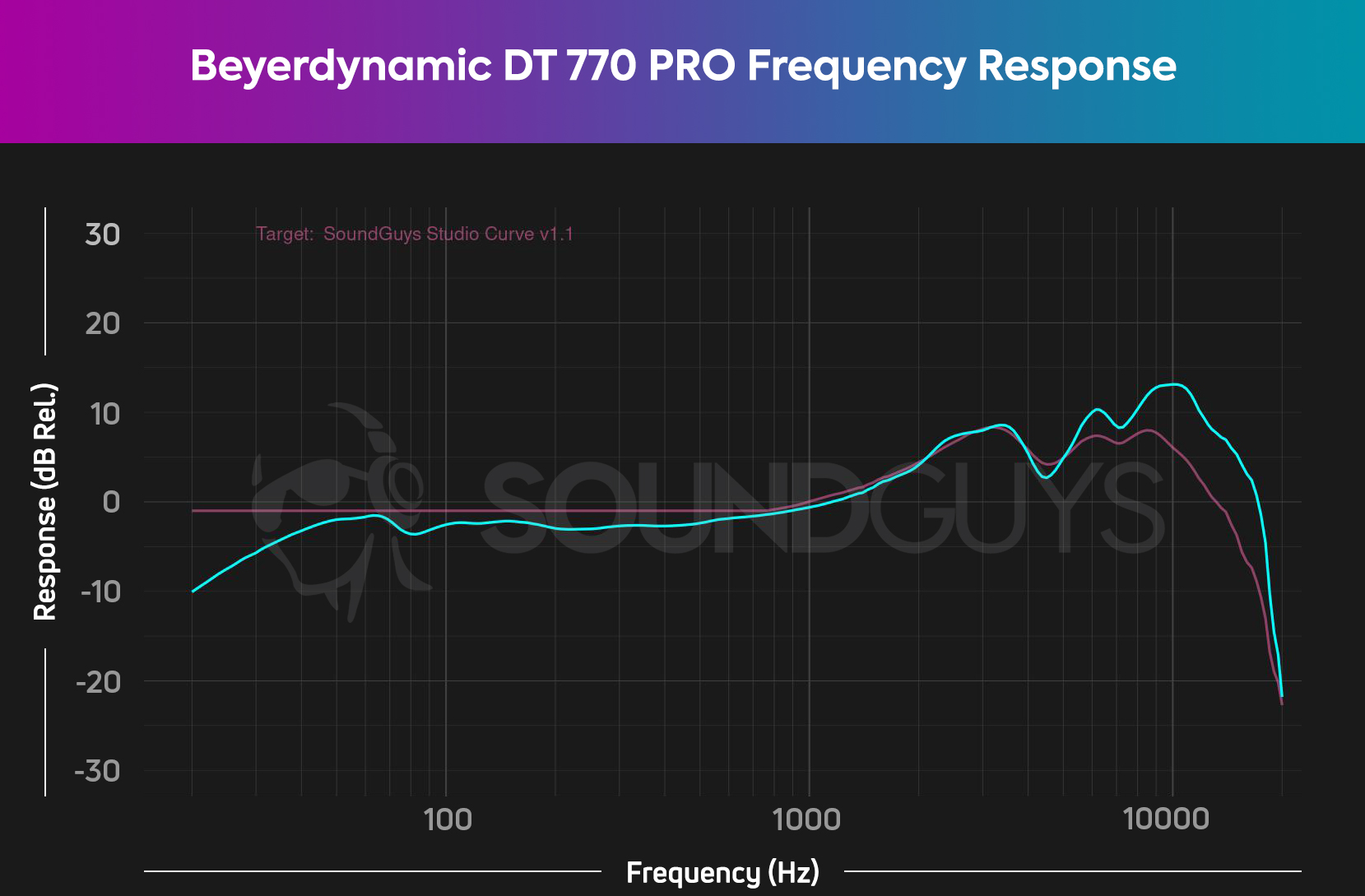
Like many of the best audiophile headphones, the Beyerdynamic DT 770 Pro (80Ω) do not color low and mid-range frequencies. This is handy for drummers, given many drum fundamentals are found between 50 and 250Hz. The boost above 7.5kHz may sound grating to some, but others may enjoy the added clarity of cymbal strikes.
The Beyerdynamic DT 990 Pro have the best audio quality
![Beyerdynamic DT 990 Pro[C] Beyerdynamic DT 990 Pro open-back headphones.](https://www.soundguys.com/wp-content/uploads/2017/11/Beyerdynamic-DT-990-ProC.jpg)
If you desire a pair of headphones with a wide soundstage and a small bass boost, the Beyerdynamic DT 990 Pro are the cans to get. However, while their open-back design produces a more subjectively pleasing sound than their DT 770 Pro sibling, it does allow more environmental sound into your music mix.
If you want studio-grade audio quality at an affordable price point, the Beyerdynamic DT 990 Pro will serve you well.
Like the DT 770 Pro, the DT 990 Pro have a robust, hard plastic exterior with a metal headband. The soft velour ear pads are extremely comfortable and play nicely while wearing glasses. They are also much more breathable and get hot less often than their leatherette counterparts. However, one caveat to bear in mind is that open-backed headphones are much more susceptible to moisture and foreign object damage. Consequently, you may feel obliged to babysit these headphones more than others on this list.
Another thing to consider is that the Beyerdynamic DT 990 Pro have a higher impedance of 250Ω. While most electronic drums should power the cans enough to provide plenty of volume, this isn’t a sure thing. If the headphones sound too quiet, you may need to invest in an amplifier. Thankfully, most USB interfaces and low-end amps should do the trick.

- Weight: 381g.
- Cable length: 3m.
- Protection against: No IP rating.
- Connections: 3.5mm TRS jack with 1/4-inch threaded adapter.
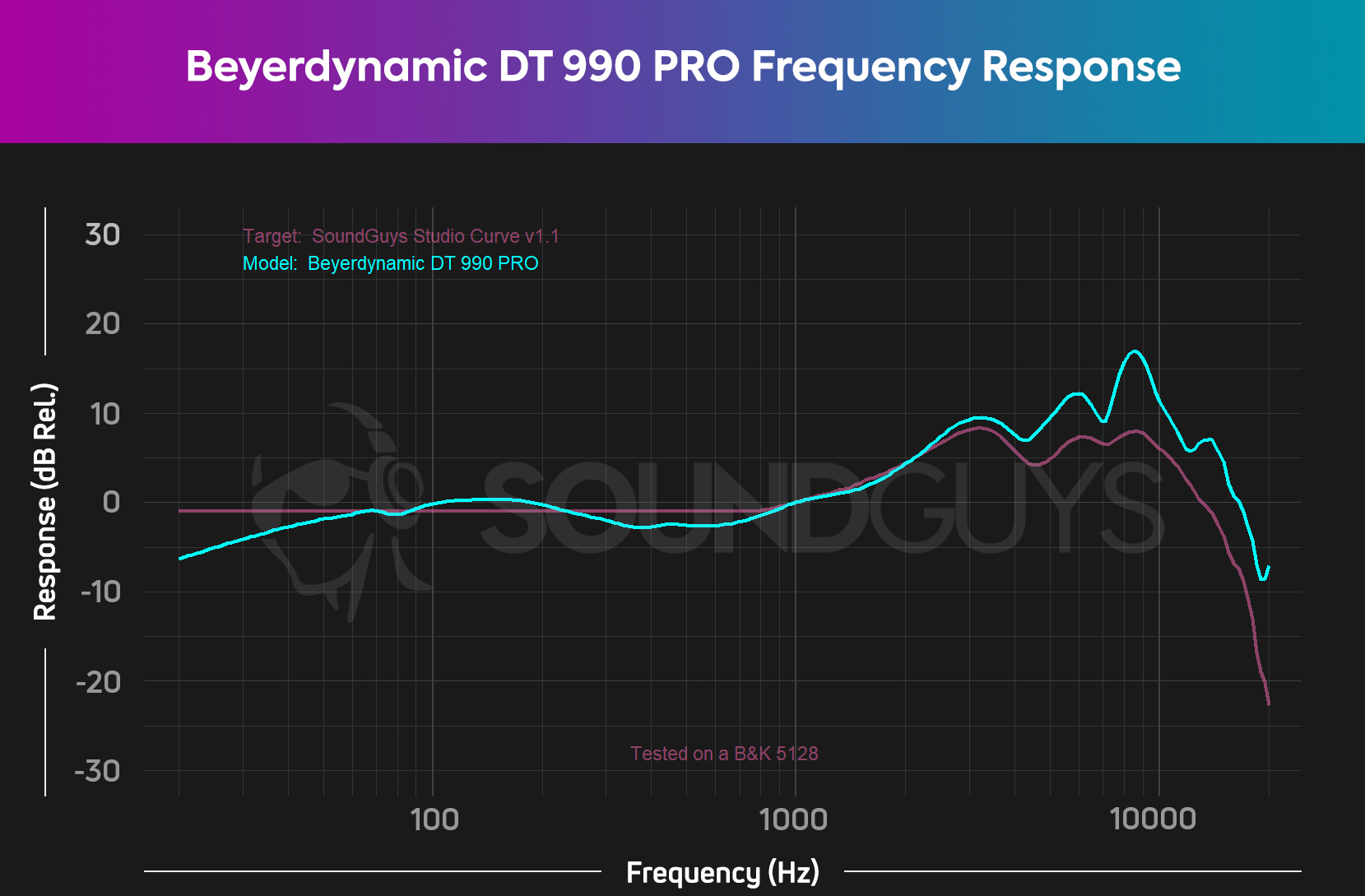
The Beyerdynamic DT 990 Pro own a slightly odd flavor of studio frequency response. In particular, the cans boost the 50-300Hz and 2kHz-20kHz ranges. The former makes kick drums sound more prominent in your mix, while the latter emphasizes cymbals and hi-hats. However, those who find the default frequency curve grating should EQ some of the accentuated high-end.
The Sennheiser HD 650 are the most comfortable
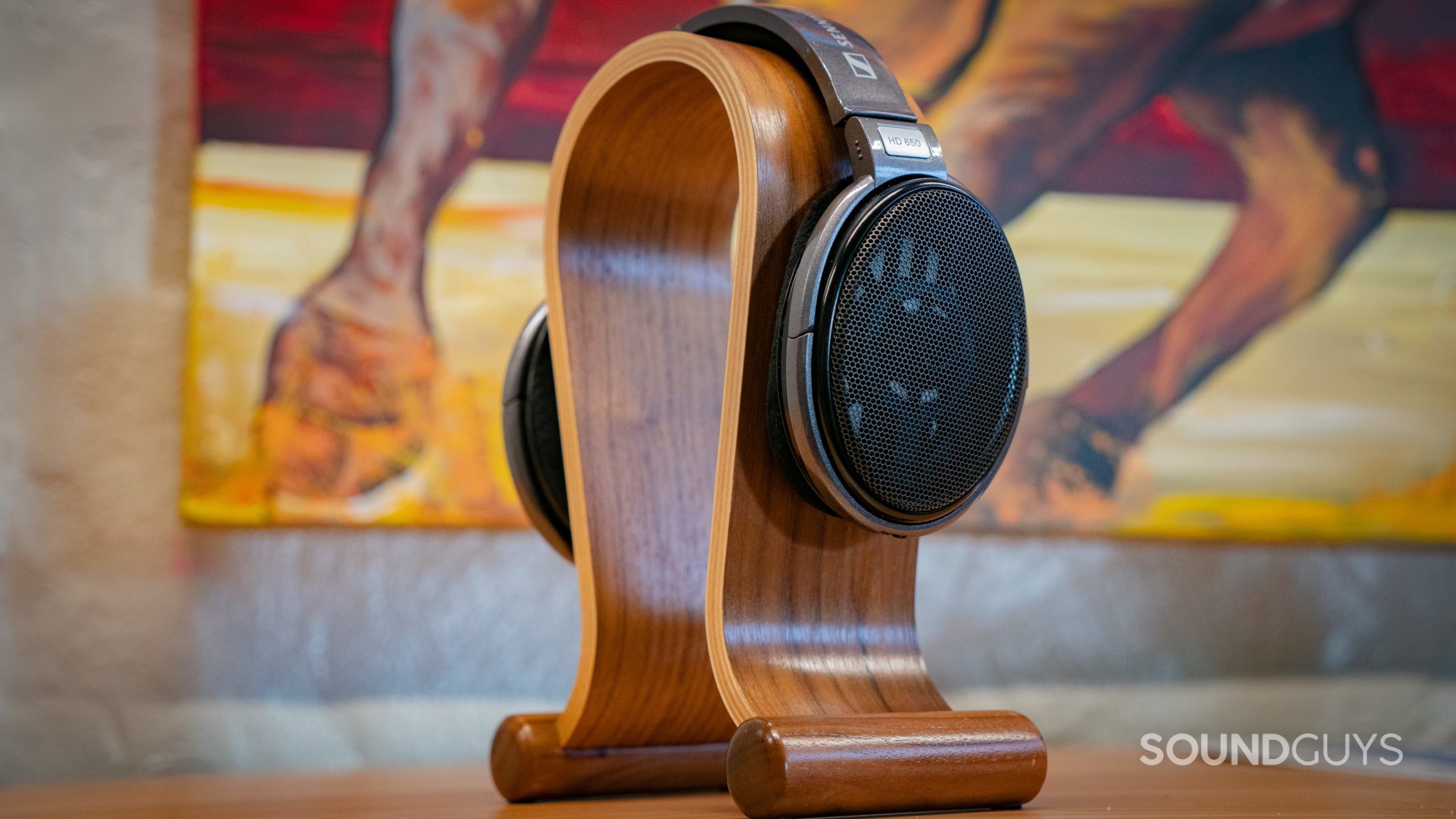
The Sennheiser HD 650, along with their HD 600 sibling, are considered by many as a true reference headphone. This is thanks to their pleasing sound signature and superior listener comfort. In particular, the HD 650 have one of the flattest frequency responses on this list.
The large oval-shaped ear pads and soft-fabric padding make the HD 650 a breeze to use for long listening sessions.
You can easily hook the HD 650 to your electronic drum kit via the 3-meter-long detachable cable which terminates in the larger standard 1/4-inch TRS plug. If your e-kit module only supports 3.5mm jack inputs, you can attach the short adapter cable to convert it to a 3.5mm jack. Like the Beyerdynamic DT 990 Pro, the Sennheiser HD 650 have a higher impedance of 300Ω. If you can’t achieve a loud enough volume straight out of the kit, you may need to purchase a separate amplifier.
Given the HD 650 are open-back headphones, you shouldn’t expect to use them outside quiet places. However, unlike other open-backs, these cans don’t exhibit any notable passive amplification (<1dB) of ambient noise. They also enjoy a wide soundstage that is handy for placing specific instruments in a three-dimensional field of hearing.


- Weight: 260g.
- Cable length: 3m.
- Protection against: No IP rating.
- Connections: 1/4-inch TRS jack with 3.5mm adapter.
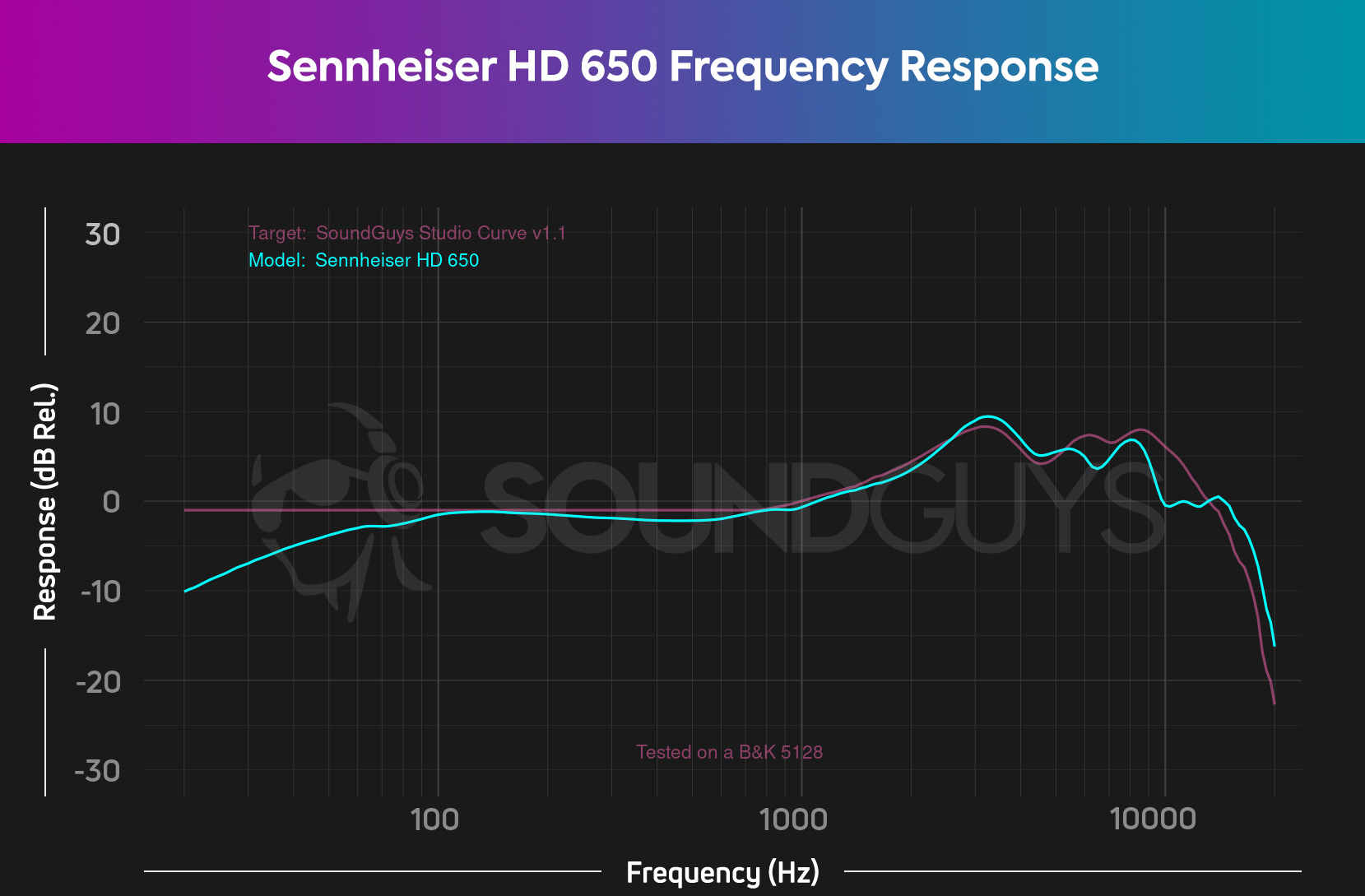
The HD 650 use an exclusive 42mm transducer model (with 38mm diaphragms) tuned by Axel Grell that is considered an industry benchmark by many. From our objective measurements, the headphones only really deviate from our studio preference curve below 100Hz and in the highs at 10kHz. Subsequently, bass and sub-bass can appear lacking on occasion. However, most people should find the Sennheiser HD 650 sound pleasing.
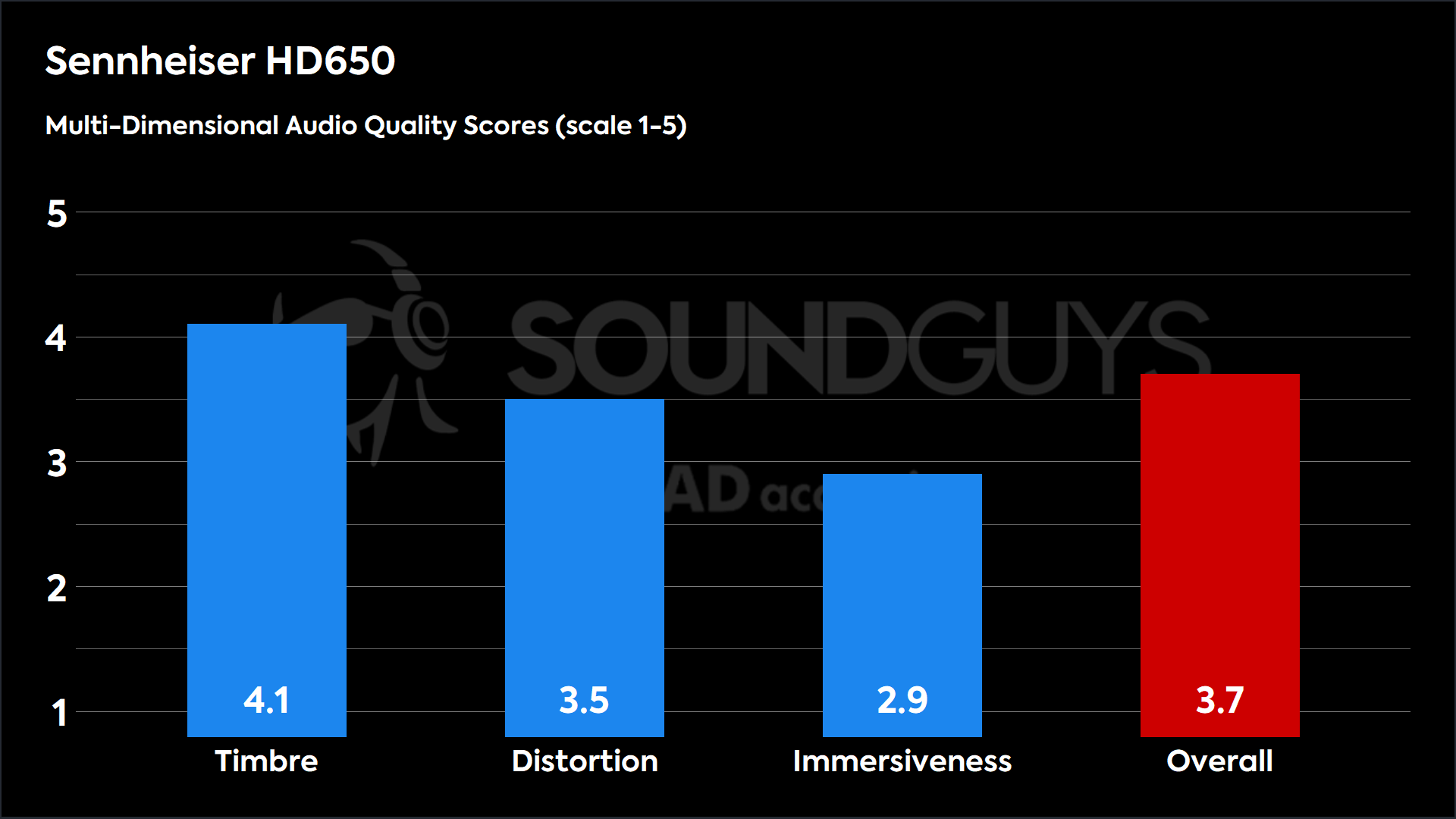
The chart above is a visual representation of how the sound of the Sennheiser HD 650 were assessed by the Multi-Dimensional Audio Quality Score (MDAQS) algorithm from HEAD acoustics. You can check out our full explainer here.
The Sony MDR-7506 are the best for small budgets
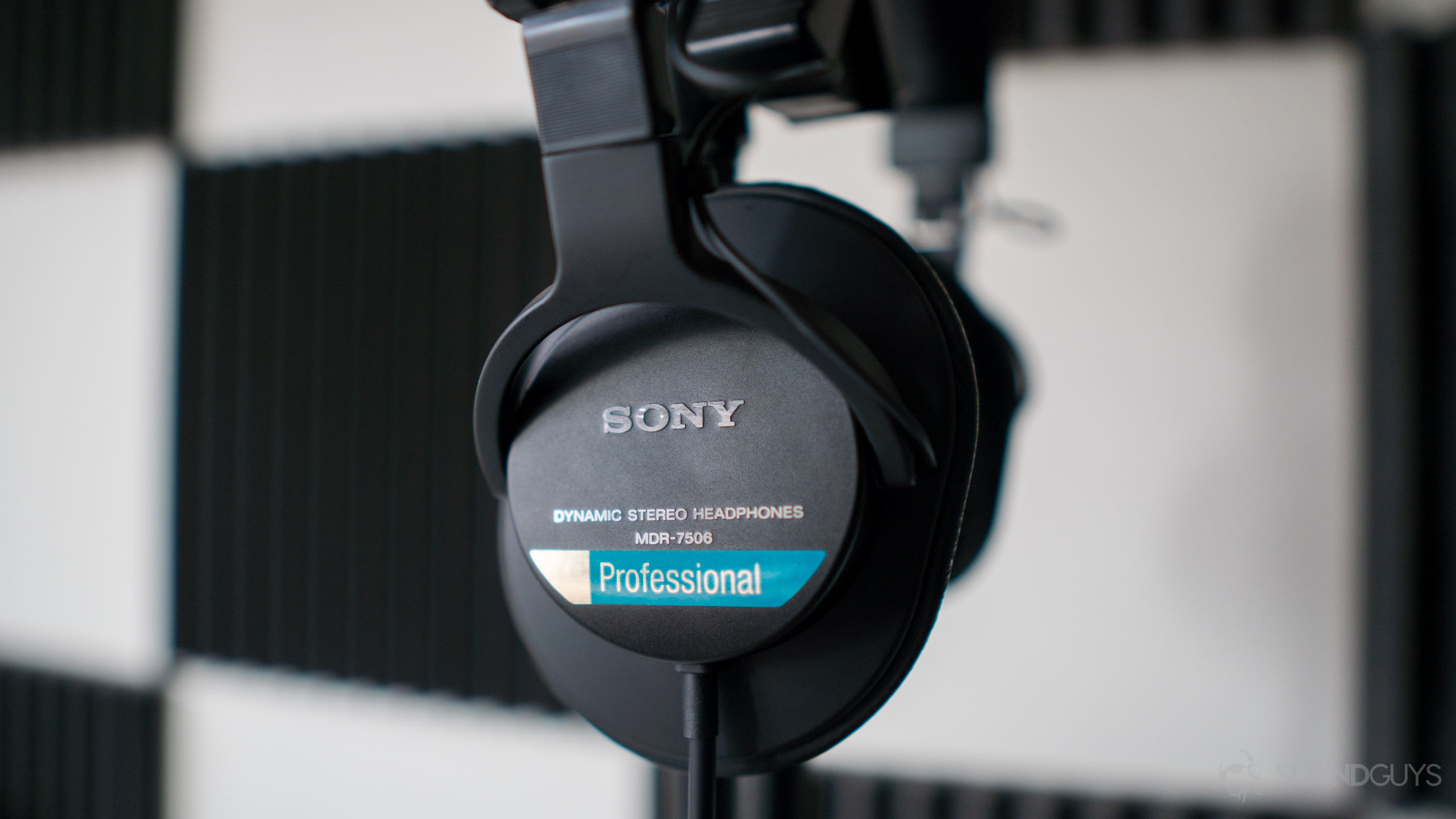
If you are after the best price-to-performance ratio, the Sony MDR-7506 fit the bill. Costing just ($89 at Amazon) and with good sound quality for mixing and music making, these cans have justifiably been a stalwart for 30 years.
Podcasters and musicians alike will enjoy the MDR-7506's unobtrusive fit, pleasing sound quality, and coiled cable.
The MDR-7506 may not have all the bells and whistles of its competitors, but they nail the fundamentals and keep the price low. Aesthetically, the headphones wear a utilitarian plastic and vinyl exterior with a foam-suffused headband and foldable hinges to minimize the 40mm driver’s footprint. The coiled cable is also handy for detaining and snaking around musical equipment. While it isn’t removable, Sony designed the MDR-7506 with repairability in mind. Given they ship with a bevy of screws and replaceable parts, they are one of the more fixable headphones on the market.
The foldable construction, slim profile, and 230g build of the Sony MDR-7506 make them the most portable headphones on this list (save for the hefty cable.) The 3.5mm jack works seamlessly with most audio devices, and the cans ship with a 1/4-inch jack adapter just in case. The closed-back headphones are also reasonably capable of blocking out unwanted environmental noise. This is most notable in the highs above 2.5kHz, where the MDR-7506 attenuate between 20dB and 40dB.

- Weight: 230g.
- Cable length: 3m.
- Protection against: No IP rating.
- Connections: 3.5mm TRS jack with 1/4-inch adapter.
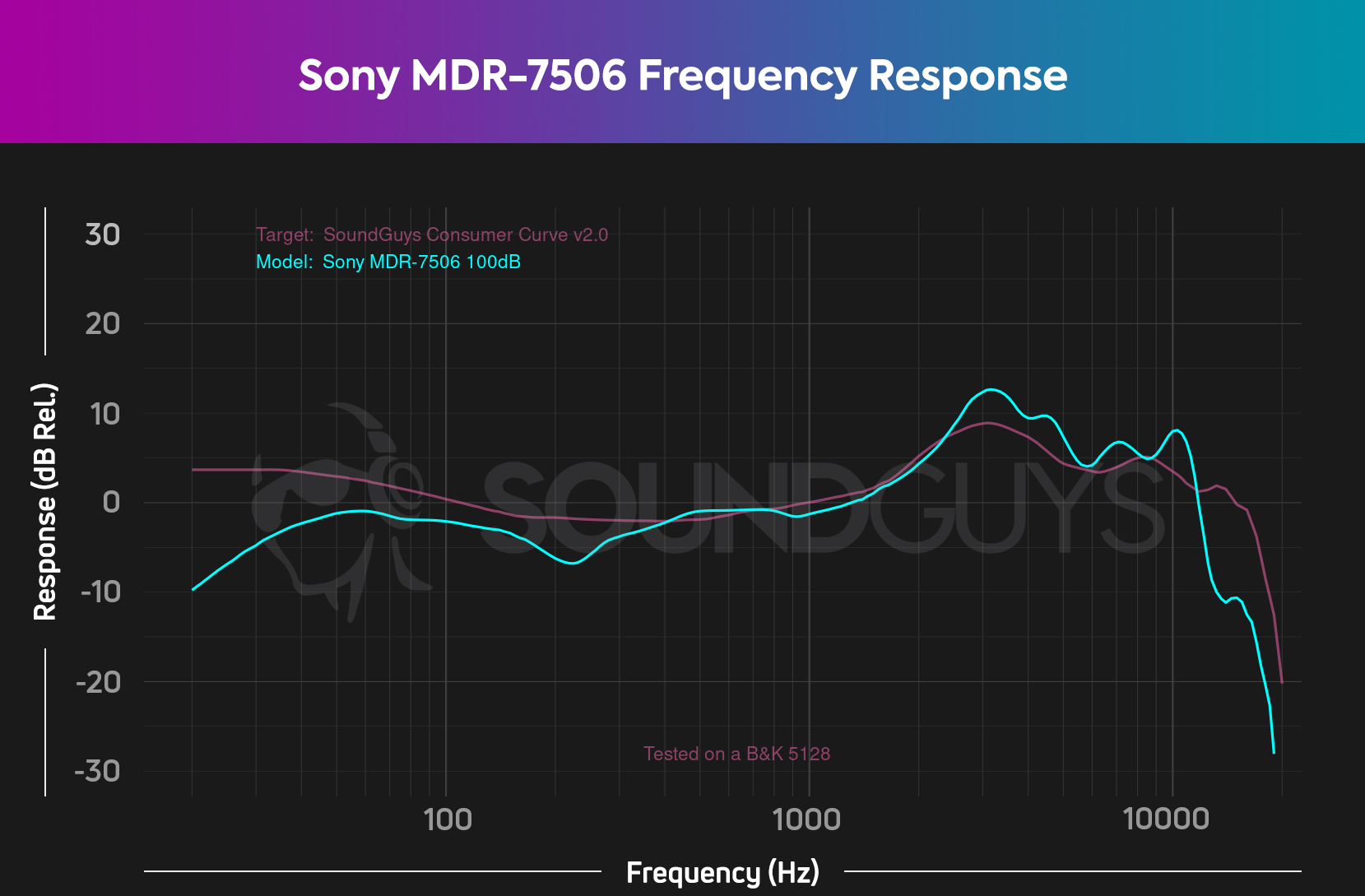
Altogether, the Sony MDR-7506 have a frequency response that most people will enjoy. However, the approximately -7dB around 200Hz can make bass drum hits sound less prominent than with other headphones. Likewise, the roll-off above 10kHz can make cymbal shimmers and hi-hats sound less bright than some of the competition.
The Audio-Technica ATH-M50x are the best for transportability and sound isolation
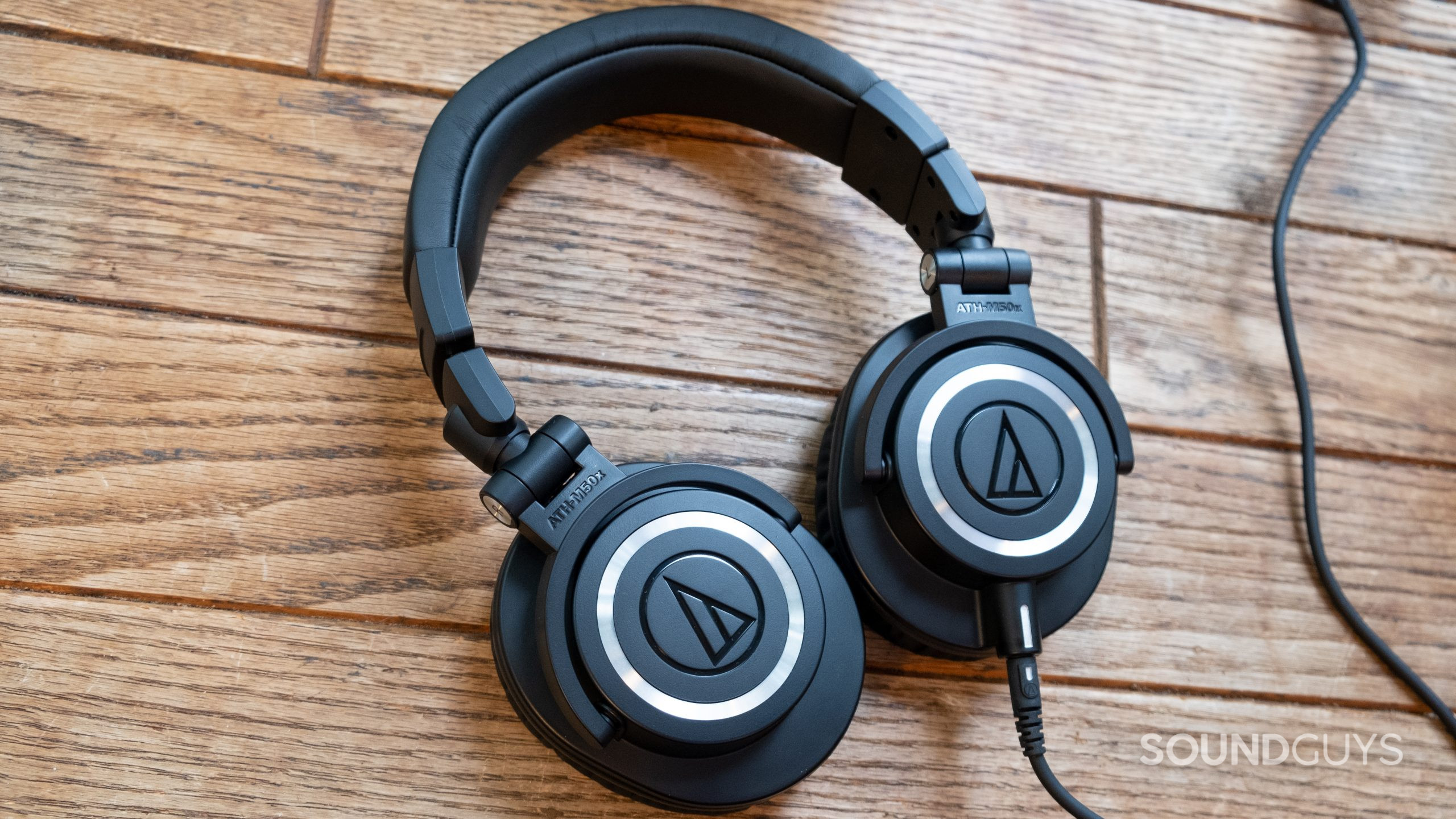
The Audio-Technica ATH-M50x are excellent for musicians, producers, and podcasters for their high performance, lack of sound leakage, and portability. The headphones are also especially effective at attenuating about 10dB at 700Hz, 33dB at 4kHz, and 38dB in ultra-high, barely perceptible frequencies.
The Audio-Technica ATH-M50x ship with a vinyl-cinched bag to protect against surface scrapes but little else.
Drummers who tour often will appreciate the collapsable design of the ATH-M50x. For example, the closed-back ear cups fold 90 degrees in either direction, and the metal-notched headband can be adjusted easily. The decent clamping force and 65 x 60mm vinyl ear pads make the headphones comfortable for several hours. However, those who wear glasses may find the cans exert too much pressure on the ears after a short period.
Unlike some of the headphones on this list, the Audio-Technica ATH-M50x do not require additional amplification. The headphones hook up strictly via wires, and the cable terminates in a 3.5mm jack with an optional 1/4-inch adapter. Perplexingly, the ATH-M50x ship with three proprietary cables that cost $20 to replace. This is much more inconvenient than using a standard 3.5mm jack cable, although Audio-Technica’s cables are reasonably easy to find online.

- Weight: 283g.
- Cable length: 1.2-3m, 1.2m, and 3m.
- Protection against: No IP rating.
- Connections: 3.5mm TRS jack with 1/4-inch adapter.
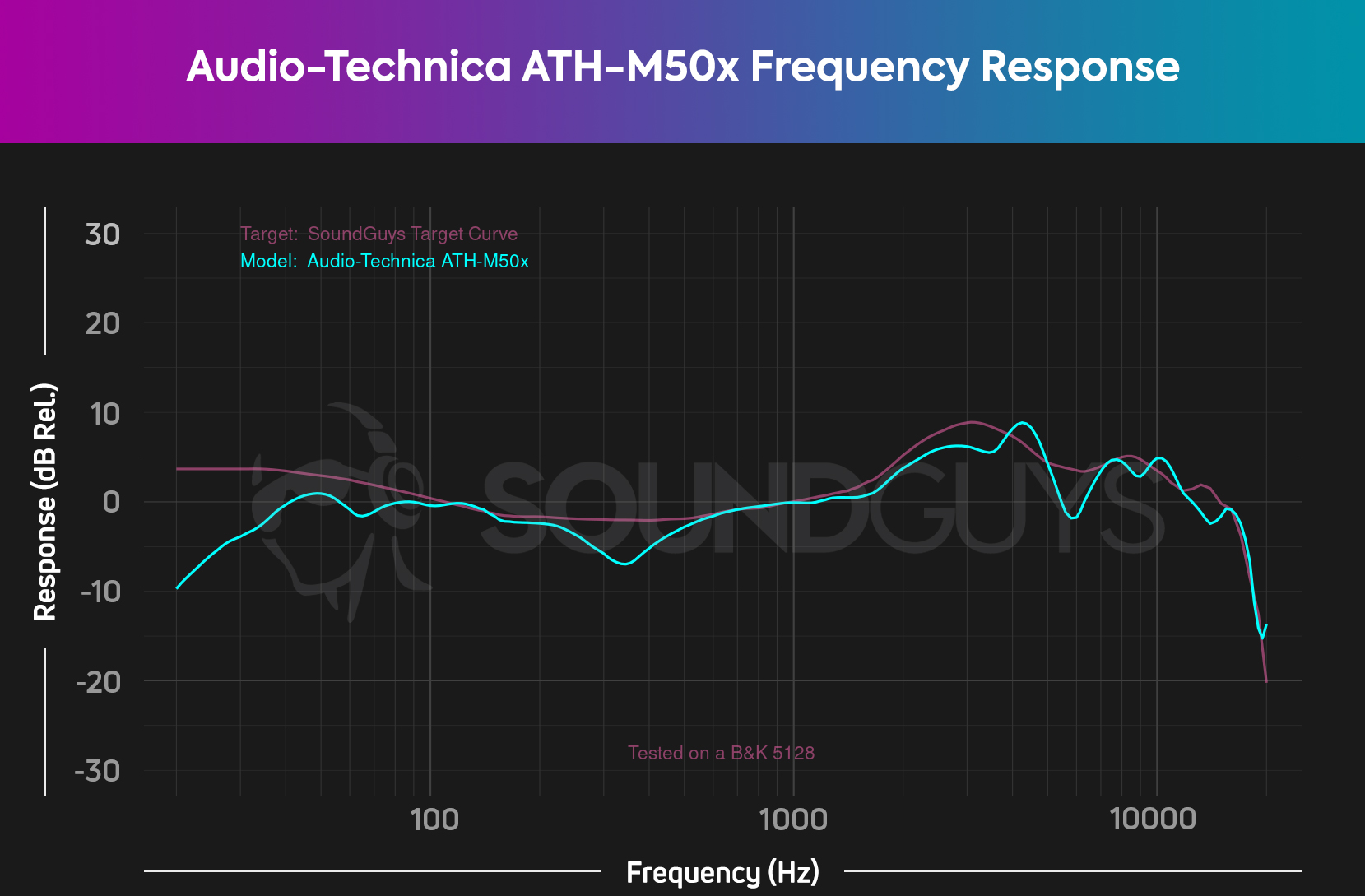
The Audio-Technica ATH-M50x marry a perfect sound profile between studio and consumer headphones. Consequently, the ATH-M50x closely follow our target preference curve and should produce sound pleasing to most listeners. The most notable areas of deviation are at 40Hz, between 300-400Hz, 3kHz, and 6kHz. The first makes the sub-mass quieter than we’d like, while the last reduces the prominence of high-end sounds like cymbals.
Who should buy the AKG K240 Studio?
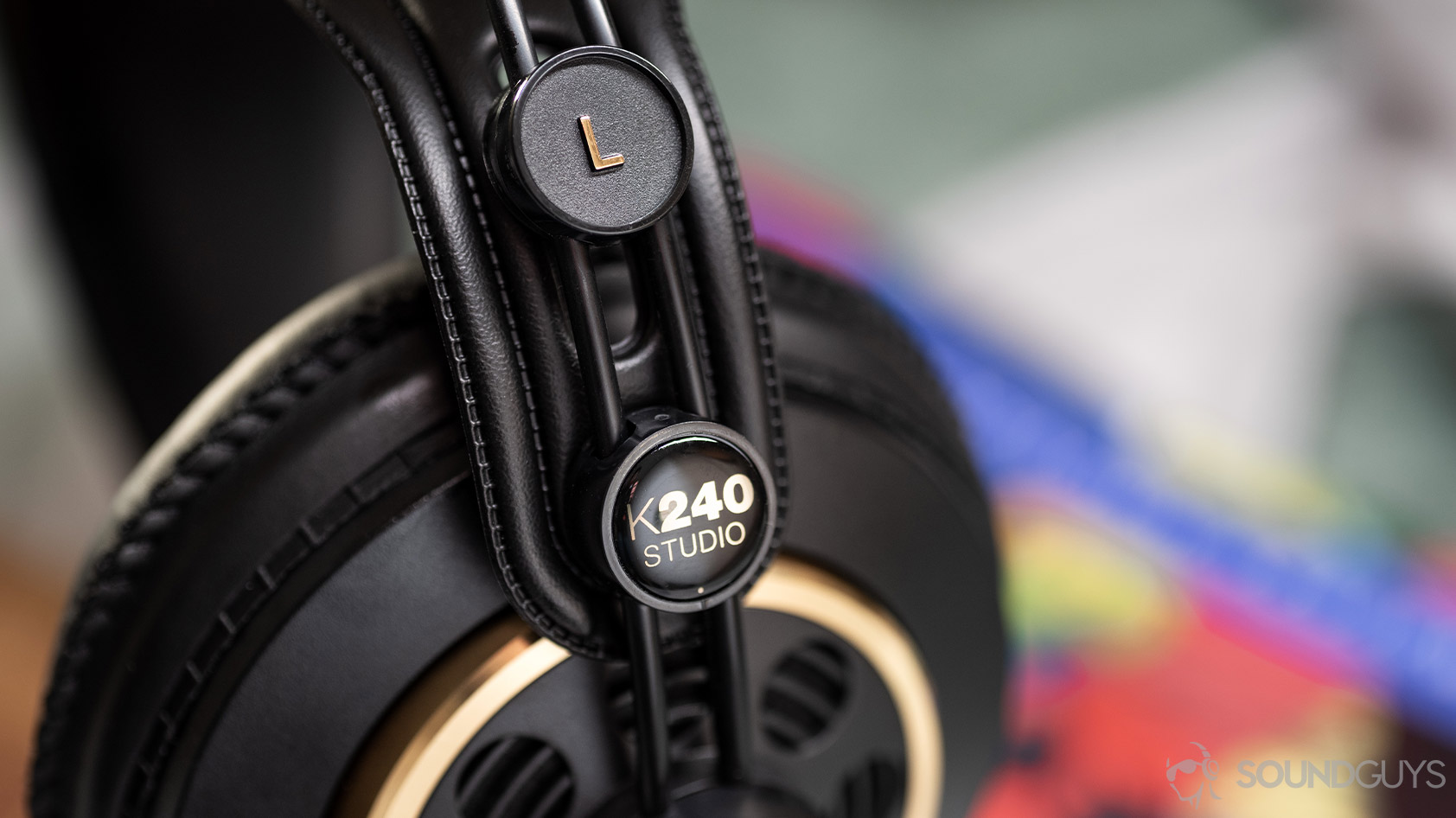
Fans of semi-open headphones should consider the AKG K240 Studio. Costing markedly less than the rest of the headphones on this list, the K240 Studio deliver accurate sound reproduction and a comfortable fit. Musicians will appreciate the uncolored sound profile and the ability to hear what you’re playing in the moment.
The AKG K240 Studio are one of the best bang-for-your-buck studio-style headphones that money can buy.
The headphones’ all-plastic build helps to retain a lightweight form factor that is easy to wear for long periods. However, this means the cans are less durable than metal-reinforced alternatives, making them a more dubious choice for taking on the road. In particular, the headband rails and plastic pivot points feel less robust than we would like. Nevertheless, the semi-open design is comfortable, great for ventilation, and creates a more realistic representation of the sound you put through them.
Like more premium headphones, the AKG K240 house a mini-XLR input on the left ear cup. This works with the included XLR-to-3.5mm TRS cable to deliver high-quality lossless audio. The cans also ship with a 1/4-inch adapter for plugging into audio devices like electronic drums, amplifiers, mixers, and studio equipment. Should the cable fray or break (as has been known to happen with this model,) it is reasonably easy to find a replacement online.

- Weight: 240g.
- Cable length: 3m.
- Protection against: No IP rating.
- Connections: mini-XLR to 3.5mm TRS jack with 1/4-inch adapter.
The best headphones for electronic drums: Notable mentions
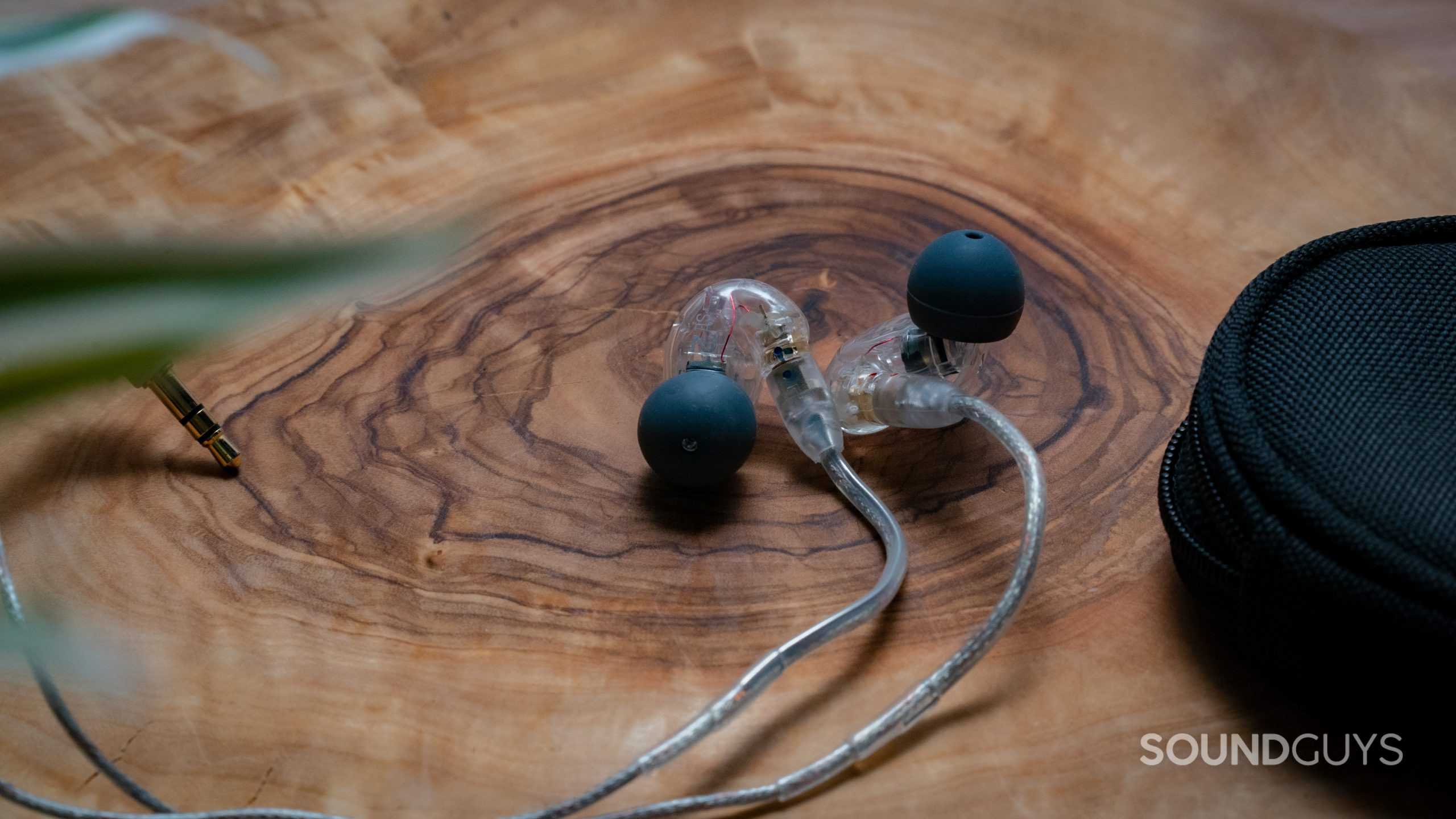
- Roland VMH-D1 ($179.99 at Amazon): The Roland VMH-D1 have a pleasing 5Hz to 40kHz frequency response that delivers a faithful representation of Roland V-Drums and other electronic kits. The cans are also fitted with a memory foam headband and earcups and come packed with drummer-friendly features including a cable restraint, a spring-loaded clip, a soft carry pouch, and a 1/4-inch jack adapter.
- OneOdio Pro-10 ($32.98 at Amazon): These DJ-inspired headphones are a reliable and affordable option. Shipping with separate 3.5mm and 1/4-inch jack inputs, the OneOdio Pro-10 can hook up to virtually any electronic instrument and be daisy-chained to share the same monitor mix with others. Regarding audio quality, the headphones sound pleasing with a bump in the mids that accentuates snare drums.
- Sennheiser HD 280 Pro ($87 at Amazon): The Sennheiser HD 280 Pro are revered for their neutral midrange response and comfortable fit. While kick drums may sound comparatively lacking, these headphones are excellent for mixing or tracking electronic drums over long recording sessions. They also enjoy a tight seal to block out unwanted incidental noises like drum taps.
- AKG K371 ($176 at Amazon): Bringing high-fidelity audio at an affordable price point, the AKG K371 enjoy a frequency response that follows our target preference curve closely. They are also exceptionally comfortable and ship with a tranche of handy accessories. Touring musicians will enjoy their portability and compact design that is lighter and less cumbersome than the Audio-Technica ATH-M50x.
- Roland RH-A30 (on the product's website): The Roland RH-A30 wear a robust steel form factor and opt for an open-back ear cup design. The 45mm neodymium magnetic drivers offer pleasing sound quality suited for electronic drums. However, the headband is markedly thin compared to others on this list.
- Shure SE846 PRO Gen 1 ($899 at Amazon): In-ear monitor fans with cash to burn should consider the Shure SE846 PRO Gen 1. With excellent-sounding balanced armature drivers, a load of accessories, interchangeable frequency filters, and superior passive isolation, these are the IEMs to beat. However, the extremely high price tag will be too dear for some.
- Vic Firth Stereo Isolation Headphones V2 ($87.95 at Amazon): Designed with live performance in mind, these headphones attenuate an average of 20dB across the frequency spectrum. The closed-back design and 50mm drivers also deliver pleasing bass and sub-bass reproduction. The redesigned headband of their predecessor also makes these cans comfortable for long periods.
- Roland RH-5 ($44.99 at Amazon): Weighing under 200g, the Roland RH-5 are among the most lightweight over-ear headphones on this list. While this is handy for achieving a comfortable fit for long practice sessions, the all-plastic construction is dubious. However, the headphones’ flat frequency response and cheap price tag will appeal to many.
- Alesis DRP100 ($59 at Amazon): Built specifically for electronic drum monitoring, the Alesis DRP100 deliver a sturdy build, superb isolation, and balanced audio quality through 40mm drivers. The sweat-proof silicone headband is welcome, but the lack of soft and thick padding means these cans may be difficult to wear over long periods.
- Shure SRH840 ($149 at Amazon): These compact headphones are excellent for drummers and DJs thanks to their 180-degree rotating ear cups. The padding is also thick and the ear pads can be replaced when needed. The Shure SRH840 have a pleasing and neutral frequency response that faithfully reproduces the sound of electronic drums.
- Roland RH-300V ($179.99 at Amazon): Sporting memory foam ear cups and a cushioned headband, the Roland RH-300V are comfortable for long recording sessions. The headphones also ship with a cable retainer for tangle-free drumming. The 50mm drivers reproduce pleasing sound quality that most people will enjoy.
- Shure SE215 ($99 at Amazon): The Shure SE215 are an affordable pair of in-ear monitors that excel at passively isolating unwanted environmental noise. The build feels sturdy, and the removable MMCX cable is handy if you need a replacement. The in-ear monitors also have a pleasing frequency response profile and ship with a list of ear tips.
Please help us improve our recommendations by participating in our poll!
How much are you willing to spend on headphones for electronic drums?
What you should know about the best headphones for electronic drums
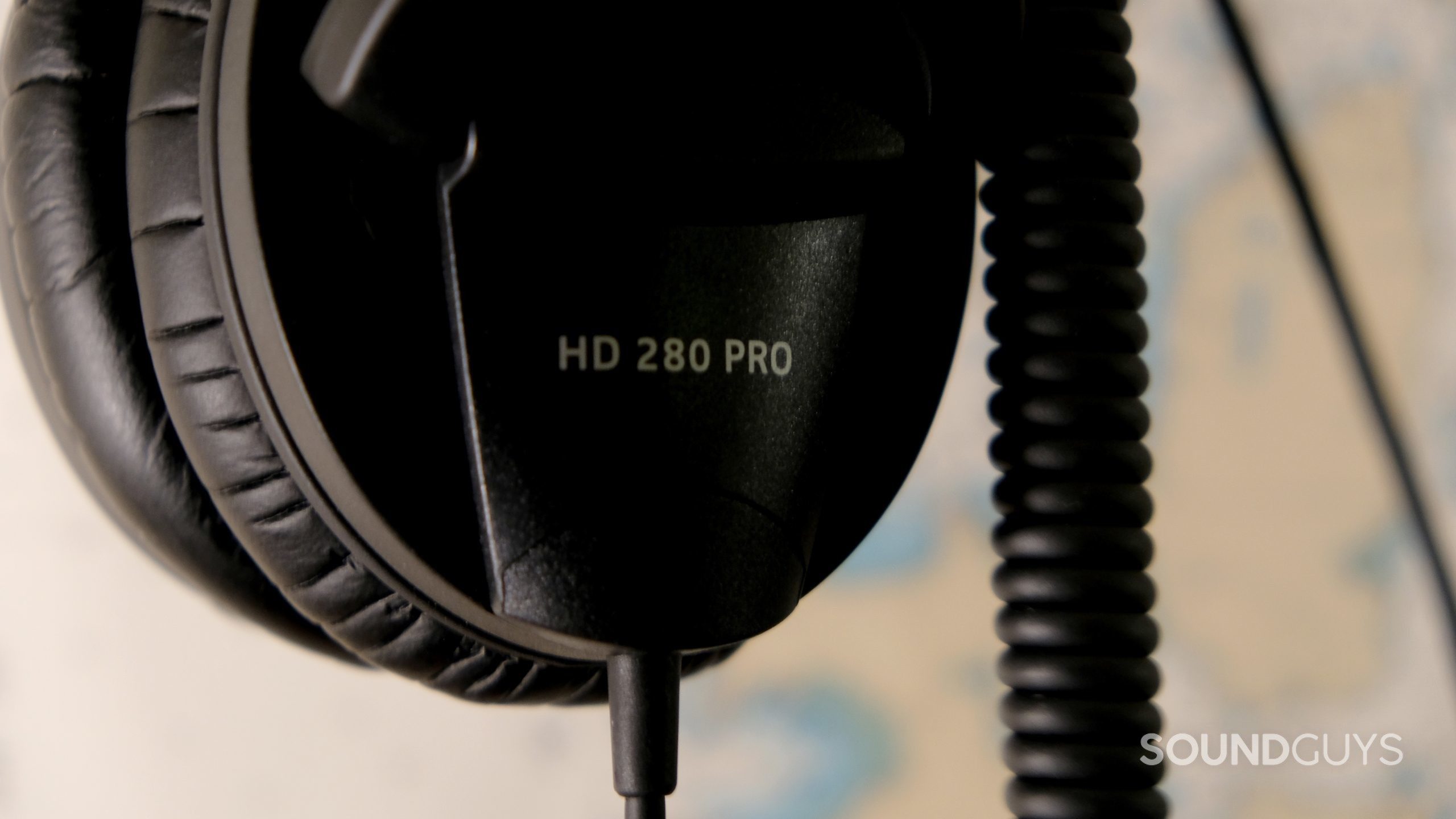
Defining “the best” headphones for electronic drums is an understandably subjective topic. While this list is aimed at appealing to musicians with different wants, our picks may not necessarily reflect your needs. Consequently, we always recommend our readers consider every purchasing factor that is important to them before committing money. Our list features many headphones deemed industry pioneers and long-time favorites. However, if you need something specific, read our other lists and feature articles to gain as much knowledge as possible. This should help you to make the right choice when the time comes to put money on the table.
One of the most important questions facing drummers is whether they prefer over-ear headphones or in-ear monitors. However, there are other aspects to consider like whether you need headphones that accommodate wearing glasses or piercings. Similarly, you may want a pair of headphones that are suitable for silent practice at home and touring. These can all be realized in our reviews and other best lists.
Closed-back, open-back, or semi-open-back headphones?
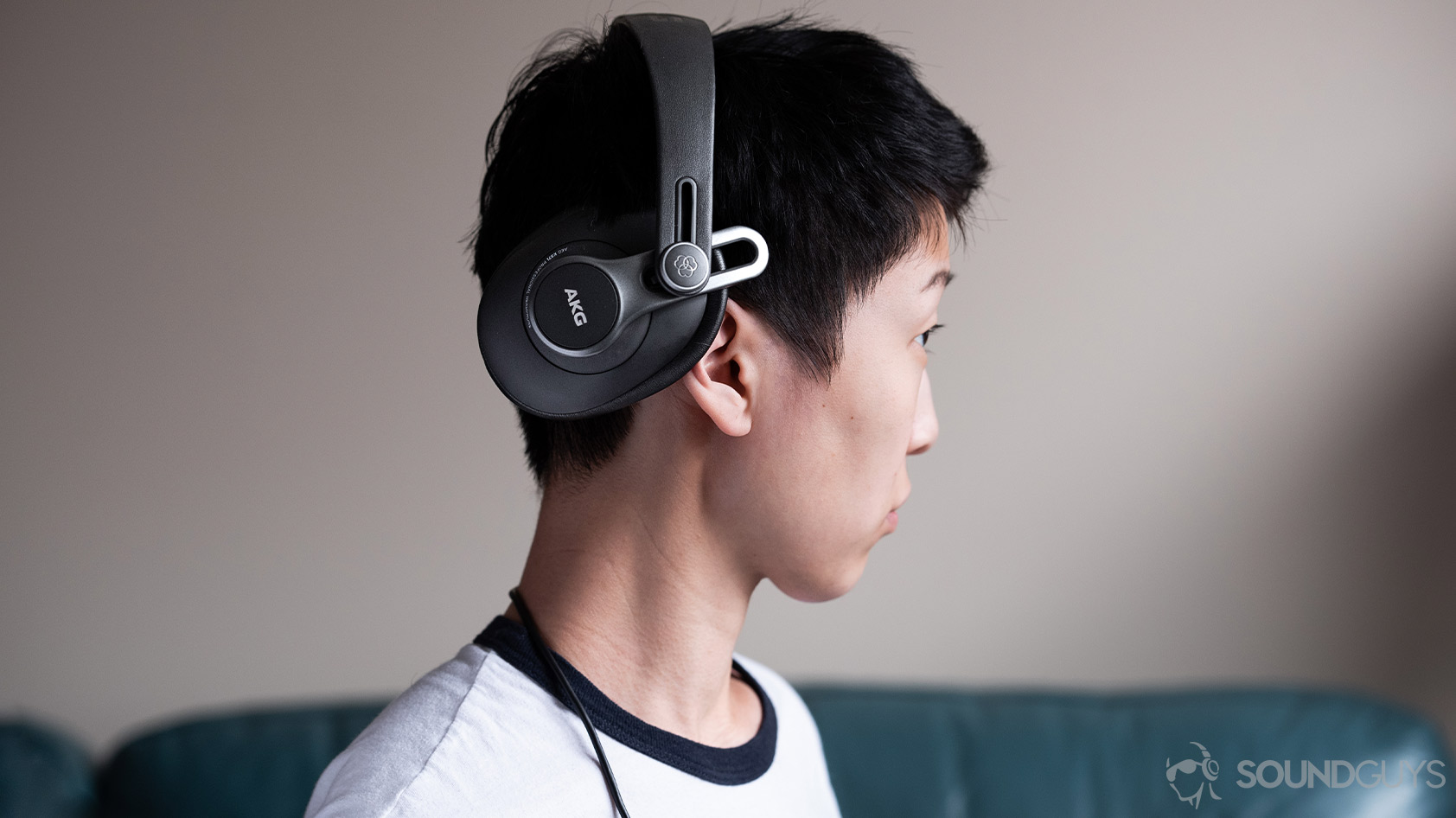
Our best headphones for electronic drums list contain a mixture of open-back, closed-back, and semi-open-back headphones. It is important to know the difference if you are forking out hundreds of dollars and plan to use your cans regularly. None are technically “better” than the other, and all have pros and cons.
As the name suggests, open-back headphones reveal the rear of the speaker driver through grills and gaps in the back of the ear cups. This has many benefits, including a more natural representation of the music you put through them and less resonance and low-frequency build-up than their closed-back counterparts. They also enjoy a wider soundstage so the listener can more easily place instrumental detail in a three-dimensional audio field. This is handy for drummers, producers, and general critical listening. However, open-back headphones do a pretty poor job of blocking unwanted outside noise. They also leak your audio so those around you can hear your music. You have to take special care of open-back headphones, too. They are usually much more susceptible to moisture and other debris getting into the sensitive internal components than their closed-back cousins.
Hard-hitting drummers might consider closed-back headphones to avoid hearing pad hits.
Owning completely sealed ear cup rears, closed-back headphones block out much more incidental noise. This design also emphasizes low frequencies that sound less natural due to the resonances of the sealed rear air volume. More generally, closed-back headphones sound less natural and produce a less wide soundscape than open-ear headphones. They also tend to get a little hotter when worn over long periods. However, the extra isolation is excellent for taking your music out and about and stops passersby from hearing your playlist.
Semi-open-back headphones are the best of both worlds and don’t completely seal the rear of the speaker elements. This allows air passage in and out of the chamber and reproduces music more pleasingly than many closed-back headphones. However, like open-back headphones, semi-opens will leak your music into public spaces and won’t isolate your mix well. Subsequently, they are best suited for at-home practice, studio work, and critical listening.
What is a flat frequency response?
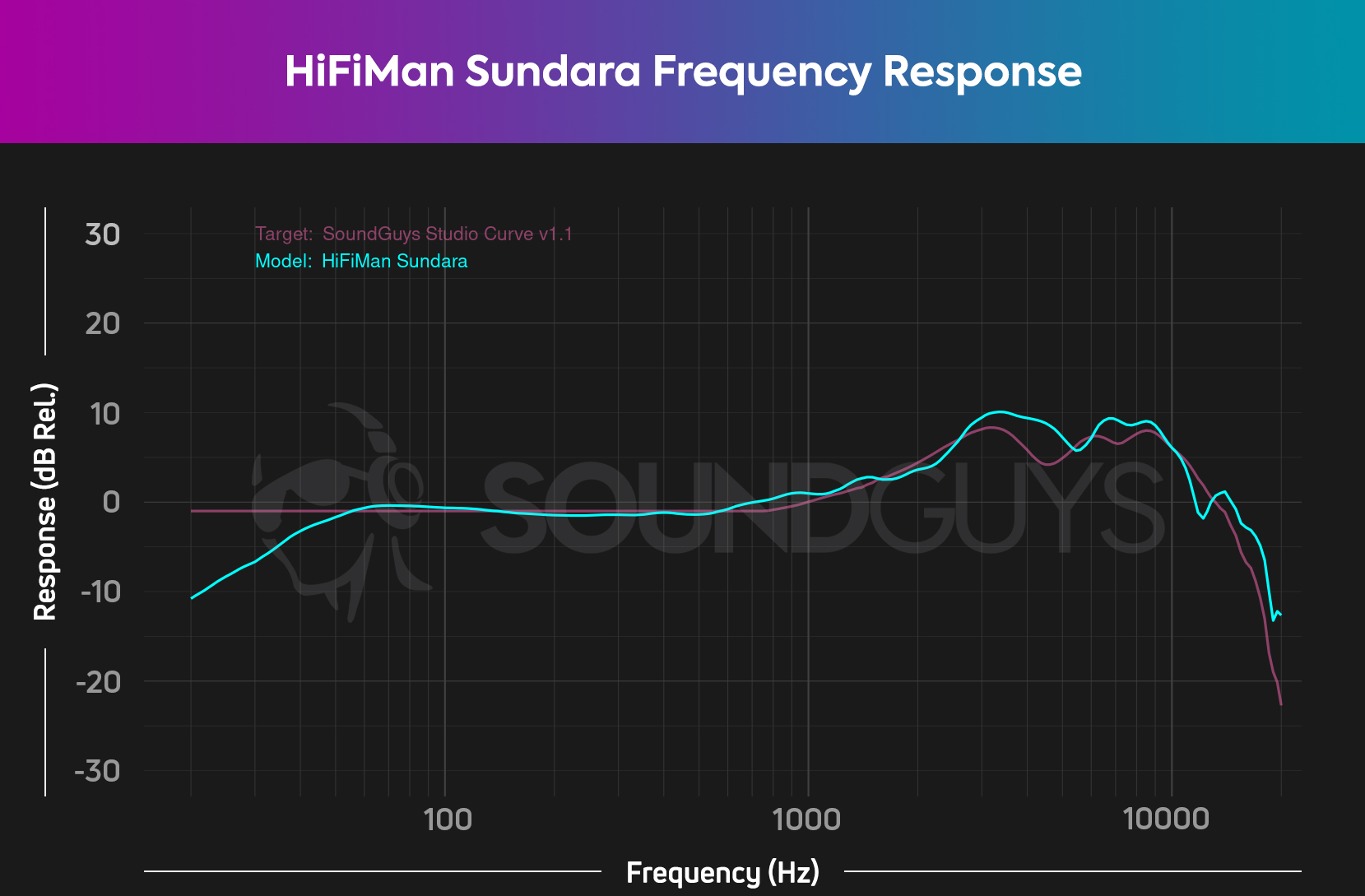
If you have ever hung around audiophiles, you will have likely heard of the term “flat frequency response.” This refers to a sound profile that deviates from 0dB as little as possible. This means an audio device reproduces music with no significant peaks or troughs to make specific frequencies louder or quieter. The pursuit of a neutral sound profile is not just desirable by audio fanatics, though. Musicians and producers also benefit, given a flat frequency response reproduces music as faithfully as how it was recorded.
All the headphones on this list own a reasonably flat frequency response that most people will find pleasing. In particular, the Sennheiser HD 650 have very neutral midrange reproduction. This is excellent for hearing back snare drums and rack toms with little coloration. However, some may find kick drums lack oomph and therefore desire headphones that boost bass and sub-bass frequencies. The Beyerdynamic DT 990 Pro have a very subtle “U-shaped” curve that does this. They also accentuate high-end frequencies that can make cymbal shimmers and hi-hats appear harsh to some listeners. No matter which headphones you pick, it is always worth getting to grips with your electronic drum kit module to hone your sound. There are also plenty of third-party EQ apps to try when connecting headphones to other devices like laptops and phones.
How we test the best headphones for electronic drums
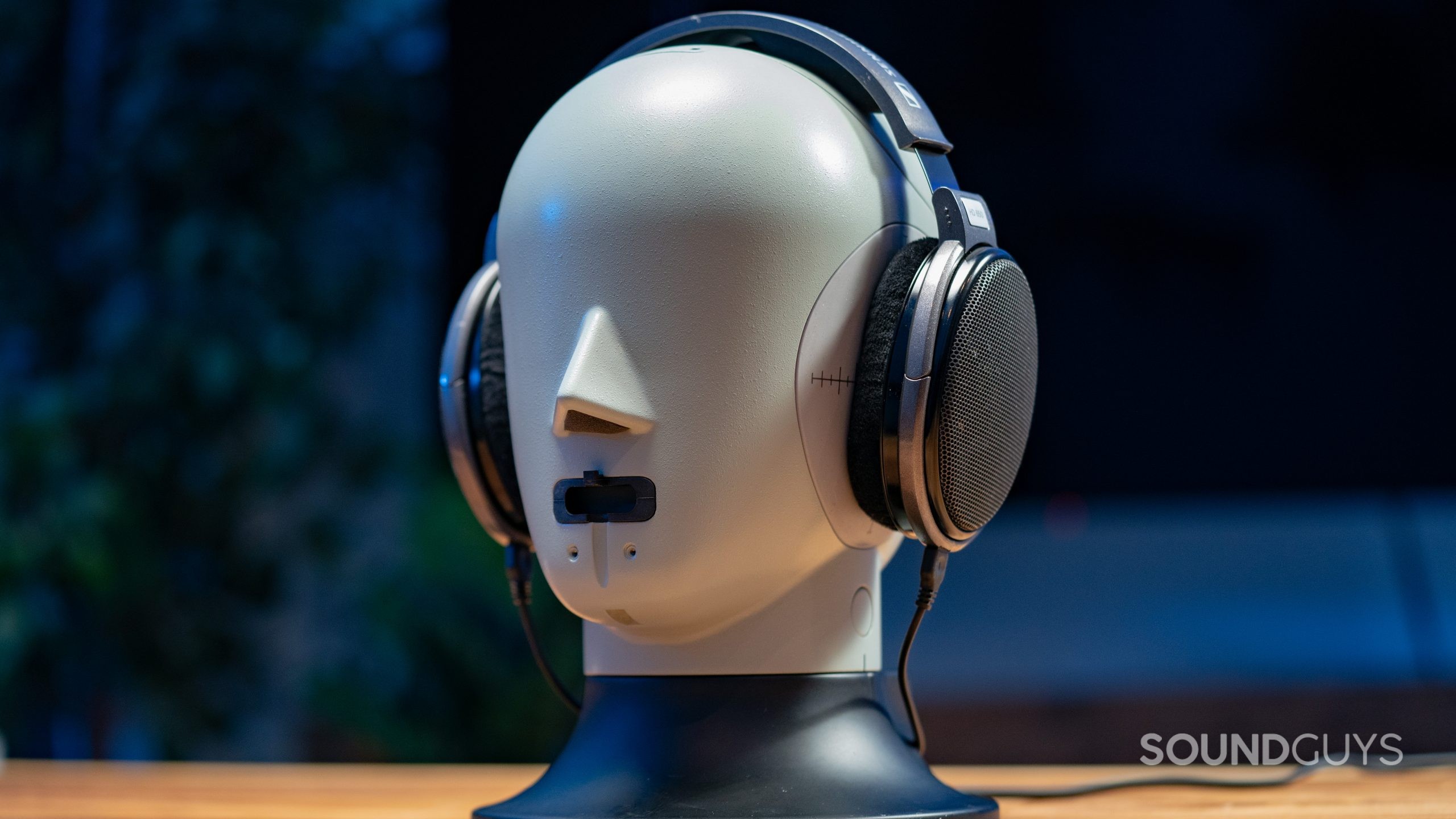
We rigorously test each product and put them through their paces to gather all the information about how well they work. For example, every headphone is subjected to scientifically verifiable performances using standardized tests in controlled conditions. Our team of professionals also spend their days getting to know the ins and outs of each product to provide user-focused feedback. The SoundGuys team comprises musicians who understand the many desirable features drummers look for in headphones.
From studying a product’s connectivity options to testing its default frequency response, we aim to provide honest and scientific feedback in our reviews. Our target preference curve is based on years of subjective perception and objective measurements of close to 700 headphones. The compendium of reference headphones includes recent AKG, Apple, Audeze, Bose, Google, Jabra, KEF, Monoprice, Shure, and Sony headphones. We believe the mixture of years of experience, hands-on reviews, and scientific measurements lends us authority in choosing some of the best headphones for electronic drums.
How we choose the best headphones for electronic drums
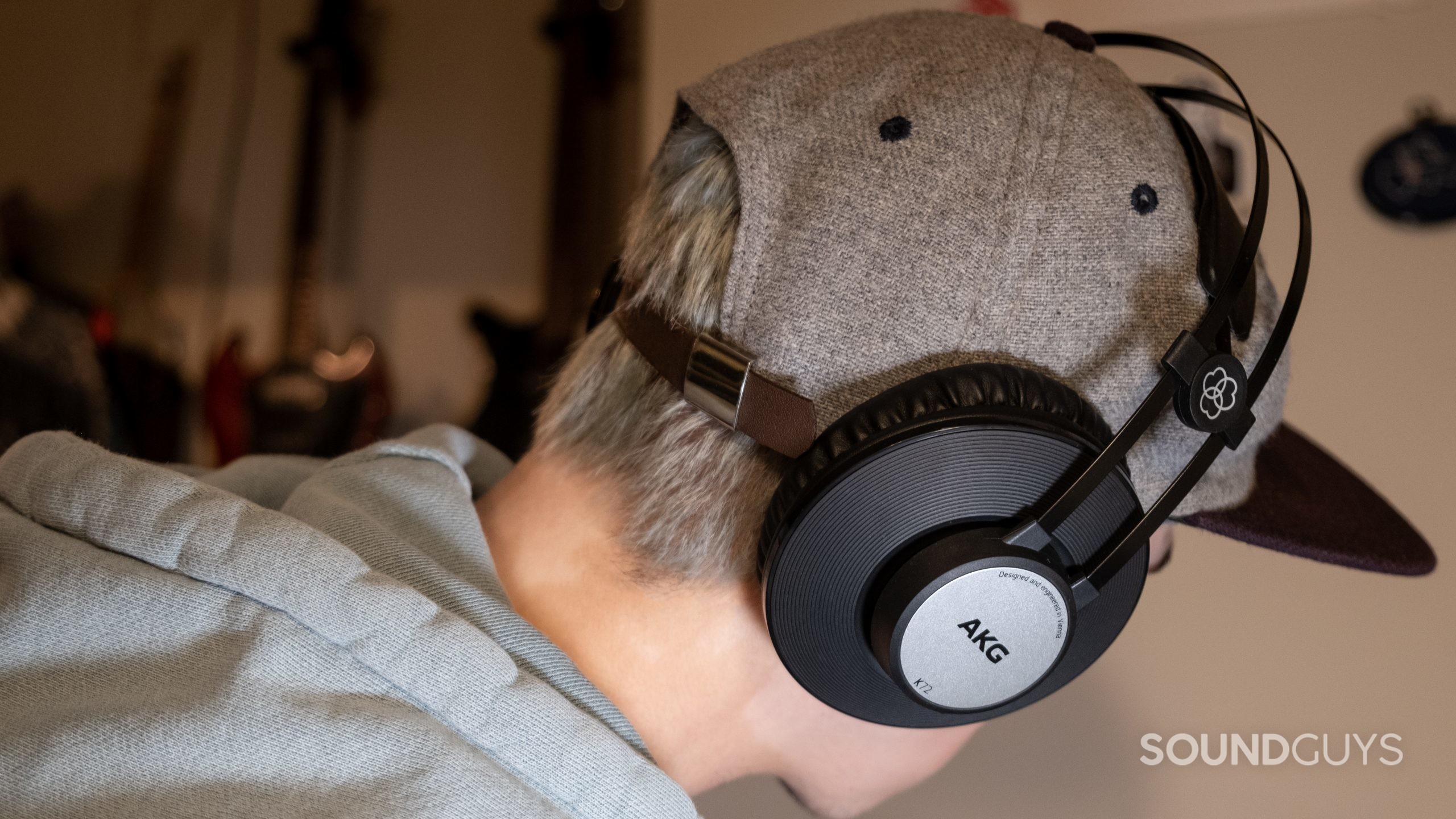
Like most consumer electronics, headphones are built for different purposes. Consequently, we took the time to consider how drummers use headphones and which features are most desirable. While we listed a variety of closed-back, open-back, and semi-open-back headphones, it is worth taking the time to read the descriptions to ensure they are right for you. Very few headphones are masters of everything, so consider which features are important to you before committing.
Some may be upset that we did not solely list audiophile-grade headphones. However, it is important to us that our readers are satisfied with their headphone’s price-to-performance ratio. Given the physical nature of drumming, many ultra-expensive headphones would be a poor choice for most drummers. Headphones break and many cheaper alternatives profit flagship features for a fraction of the price of more senior brands. Cheaper electronic drums are also used primarily for practice instead of for high-quality audio recording. Subsequently, high-end headphones can only do so much to make your source device sound realistic. Those with a more developed idea of what kind of headphones they want or with high-end electronic drums should check out our other best lists. Not every best headphone model listed here will meet all of your needs.
Why you should trust SoundGuys
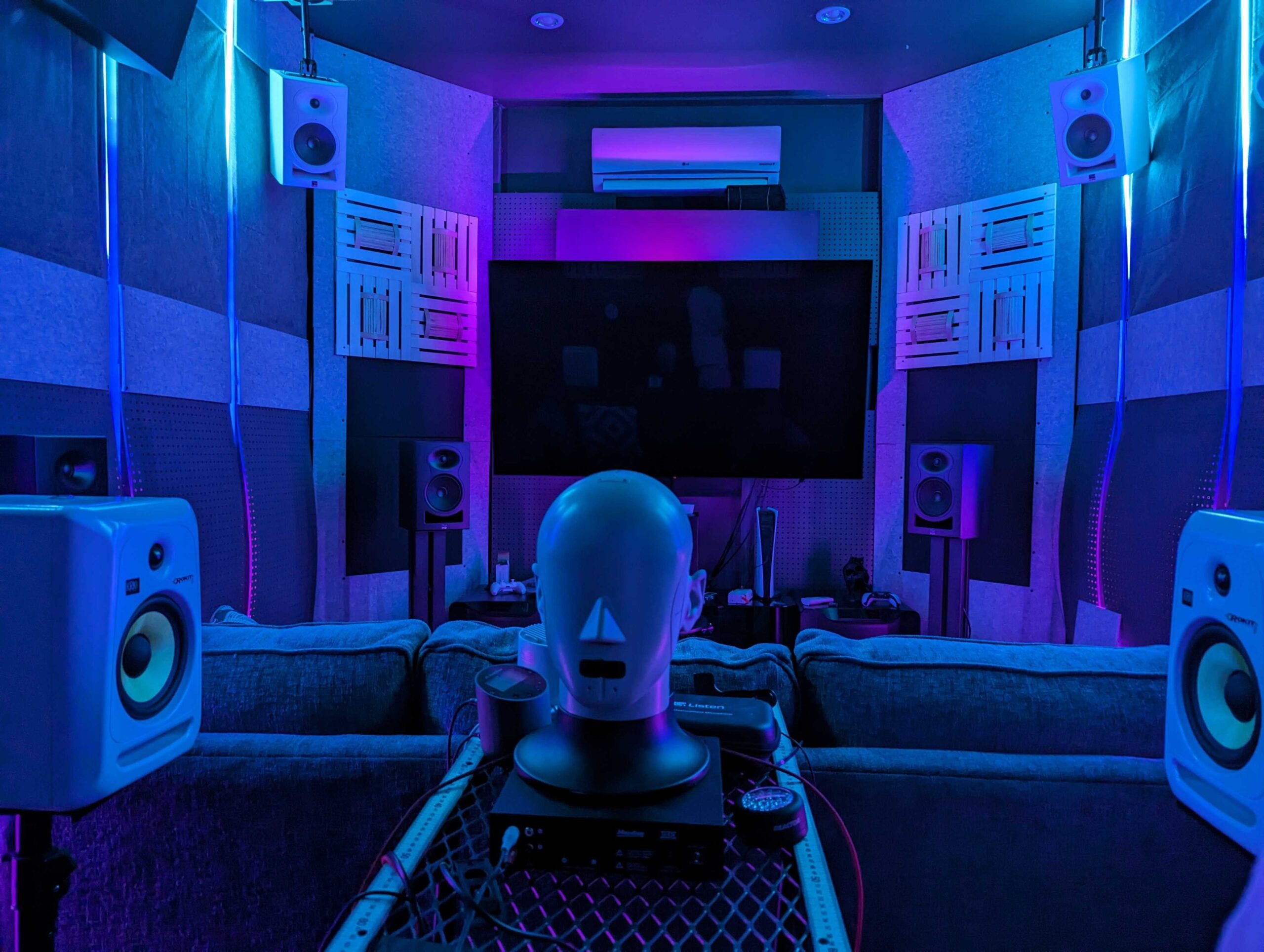
You can trust us because we show our homework and take pride in providing unimpeachable information. Our revenue model is based on the happiness of our readers with our recommendations. We don’t make money when you return a product we recommend.
The SoundGuys team has years of experience reviewing products between them. We only recommend products that have genuinely impressed us from our hands-on experience. Our best headphones lists are curated with the consumer in mind. We strive to strike a balance between cost, features, and performance.
Frequently asked questions
Yes. Most electronic drums come equipped with a 3.5mm port or MONO output. The former can be connected via a standard 3.5mm TRS cable, while the latter often uses the larger 1/4-inch TRS jack.
As featured at the top of this list, the Beyerdynamic DT 770 Pro are an industry favorite for musicians and studio professionals alike. Their closed-back design is handy for isolating your music mix from outside sounds. The cans are also extremely comfortable and breathable and have a frequency response that most people will find pleasing.
There are plenty of in-ear monitors suitable for drummers. Often, IEMs with good isolation, pleasing sound quality, long cable length, and a comfortable fit are a good bet for drumming. The Shure SE846 Pro Gen 1 are a good example of this, although their high price tag will be unattractive for many.
One of the main benefits of electronic drums vs acoustic drums is that you can easily control the volume with e-kits. Consequently, reducing the volume on your drum kit module until it is comfortable is your best bet. This is the case whether you listen to your electronic drums through headphones or an external speaker. However, purchasing third-party hearing protection like earplugs can be handy if you have sensitive hearing.
Thank you for being part of our community. Read our Comment Policy before posting.